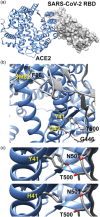Variation in predicted COVID-19 risk among lemurs and lorises
- PMID: 33792947
- PMCID: PMC8250314
- DOI: 10.1002/ajp.23255
Variation in predicted COVID-19 risk among lemurs and lorises
Abstract
The novel coronavirus SARS-CoV-2, which in humans leads to the disease COVID-19, has caused global disruption and more than 2 million fatalities since it first emerged in late 2019. As we write, infection rates are at their highest point globally and are rising extremely rapidly in some areas due to more infectious variants. The primary target of SARS-CoV-2 is the cellular receptor angiotensin-converting enzyme-2 (ACE2). Recent sequence analyses of the ACE2 gene predict that many nonhuman primates are also likely to be highly susceptible to infection. However, the anticipated risk is not equal across the Order. Furthermore, some taxonomic groups show high ACE2 amino acid conservation, while others exhibit high variability at this locus. As an example of the latter, analyses of strepsirrhine primate ACE2 sequences to date indicate large variation among lemurs and lorises compared to other primate clades despite low sampling effort. Here, we report ACE2 gene and protein sequences for 71 individual strepsirrhines, spanning 51 species and 19 genera. Our study reinforces previous results while finding additional variability in other strepsirrhine species, and suggests several clades of lemurs have high potential susceptibility to SARS-CoV-2 infection. Troublingly, some species, including the rare and endangered aye-aye (Daubentonia madagascariensis), as well as those in the genera Avahi and Propithecus, may be at high risk. Given that lemurs are endemic to Madagascar and among the primates at highest risk of extinction globally, further understanding of the potential threat of COVID-19 to their health should be a conservation priority. All feasible actions should be taken to limit their exposure to SARS-CoV-2.
© 2021 Wiley Periodicals LLC.
Conflict of interest statement
The authors declare that there are no conflict of interests.
Figures


Update of
-
Variation in predicted COVID-19 risk among lemurs and lorises.bioRxiv [Preprint]. 2021 Feb 3:2021.02.03.429540. doi: 10.1101/2021.02.03.429540. bioRxiv. 2021. Update in: Am J Primatol. 2021 Jun;83(6):e23255. doi: 10.1002/ajp.23255. PMID: 33564767 Free PMC article. Updated. Preprint.
References
-
- Bales, K. L. (2020). Special issue: Primates and COVID‐19. American Journal of Primatology, 82(8), e23174. - PubMed
-
- Barmania, S. (2015). Madagascar's health challenges. The Lancet, 386(9995), 729–730. - PubMed
-
- Barrett, M. A. , Brown, J. L. , Junge, R. E. , & Yoder, A. D. (2013). Climate change, predictive modeling and lemur health: Assessing impacts of changing climate on health and conservation in Madagascar. Biological Conservation, 157, 409–422.
-
- Birkinshaw, C. , Lowry, P. P., II , Raharimampionona, J. , & Aronson, J. (2013). Supporting target 4 of the Global Strategy for Plant Conservation by integrating ecological restoration into the Missouri Botanical Garden's conservation program in Madagascar. Annals of the Missouri Botanical Garden, 99(Issue 2), 139–146. 10.3417/2012002 - DOI
-
- Blair, R. V. , Vaccari, M. , Doyle‐Meyers, L. A. , Roy, C. J. , Russell‐Lodrigue, K. , Fahlberg, M. , Monjure, C. J. , Beddingfield, B. , Plante, K. S. , Plante, J. A. , et al. (2020). ARDS and cytokine storm in SARS‐CoV‐2 Infected Caribbean Vervets. bioRxiv. https://www.biorxiv.org/content/10.1101/2020.06.18.157933v1.abstract - DOI
Publication types
MeSH terms
Substances
Grants and funding
- GRC 2017 SGR 880/CERCA Programme del Departament d'Economia i Coneixement de la Generalitat de Catalunya
- BFU2017-86471-P (MINECO/FEDER/CERCA
- AEI (CEX2018-000792-M)/Unidad de Excelencia María de Maeztu
- Centro de Excelencia Severo Ochoa
- Canada Research Chairs Program
- Natural Sciences and Engineering Research Council of Canada (NSERC Discovery Grant)
- Secretaria d'Universitats i Recerca
- R35GM130333/NH/NIH HHS/United States
- CGL2017-82654-P/MINECO/FEDER, UE
- NERC NE/T000341/1/Natural Environment Research Council
- Howard Hughes International Early Career
- R35 GM130333/GM/NIGMS NIH HHS/United States
- Spanish Ministry of Science and Innovation - Instituto de Salud Carlos III
- UE)/CERCA
- 864203/European Research Council (ERC) - European Union's Horizon 2020 research and innovation programme
- Rockefeller University
- Generalitat de Catalunya (Departament de Salut, Departament d'Empresa i Coneixement)
- BIO2015-71792-P/European Regional Development Fund
- Obra Social "La Caixa"
- HHMI/Howard Hughes Medical Institute/United States
- MINECO/FEDER/European Regional Development Fund
- Smart Growth Operating Program (2014-2020)
LinkOut - more resources
Full Text Sources
Other Literature Sources
Medical
Research Materials
Miscellaneous

